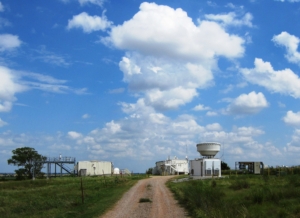Modeling
Modeling is a valuable tool in the Atmospheric Radiation Measurement (ARM) User Facility's suite of capabilities.
An important component of ARM’s mission is to contribute to the improvement of earth system models. To better link ARM observations to global-scale models, ARM has added large-eddy simulation (LES) modeling to its suite of capabilities. LES models combined with ARM observations support the study of atmospheric processes and the improvement of observational retrievals. LES model simulations constrained by observations help to bridge detailed high-resolution observations and spatially coarse global-scale models, thereby strengthening ARM’s ability to impact the development of parameterizations of clouds, aerosols, and radiation in earth system models.
LASSO
 A key ARM project combines observational and modeling elements to enable a new level of scientific inquiry. It ties together observational data and LES modeling to support the study of atmospheric processes, improvement of observational retrievals, and representations of clouds, aerosols, and radiation in earth system models. This project, called LASSO—the LES ARM Symbiotic Simulation and Observation activity—focuses on selected modeling scenarios, which are tied to specific meteorological regimes and locations where ARM has collected suites of observations.
A key ARM project combines observational and modeling elements to enable a new level of scientific inquiry. It ties together observational data and LES modeling to support the study of atmospheric processes, improvement of observational retrievals, and representations of clouds, aerosols, and radiation in earth system models. This project, called LASSO—the LES ARM Symbiotic Simulation and Observation activity—focuses on selected modeling scenarios, which are tied to specific meteorological regimes and locations where ARM has collected suites of observations.
Currently, two LASSO scenarios are available. The first scenario focuses on continental shallow convection at ARM’s Southern Great Plains atmospheric observatory. The second scenario focuses on deep convection during ARM’s Cloud, Aerosol, and Complex Terrain Interactions (CACTI) field campaign in Argentina. A third scenario, for shallow marine clouds at the Eastern North Atlantic atmospheric observatory, is in development.
Modeling Partnerships
ARM instruments are gathering the observational data required to power national and international research efforts related to earth system changes. A growing number of scientists are now making use of ARM data to better represent processes in earth system models, but challenges remain in applying ARM data to these models both because of the different spatial scales they represent and differences in perspective between observational and modeling studies. Explicit partnerships between ARM and modeling groups lead to strategies that address these challenges.
ARM is also contributing to the evaluation and development of the Energy Exascale Earth System Model (E3SM), which is supported by the U.S. Department of Energy. E3SM has a library of ARM data cases to help with testing and evaluating parameterizations in its single-column model. In addition, E3SM’s diagnostics package (E3SM-Diags) integrates the ARM Data-Oriented Metrics and Diagnostics Package (ARM-DIAGS). This integration allows users to test E3SM output at multiple ARM sites against climatology and time-series files generated from ARM data.
Keep up with the Atmospheric Observer
Updates on ARM news, events, and opportunities delivered to your inbox
ARM User Profile
ARM welcomes users from all institutions and nations. A free ARM user account is needed to access ARM data.


















